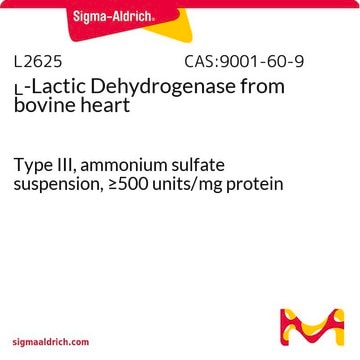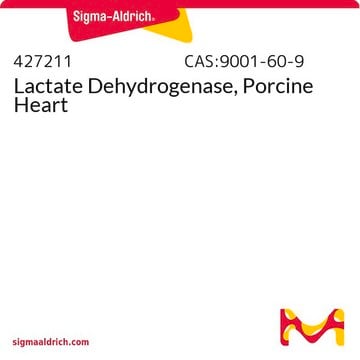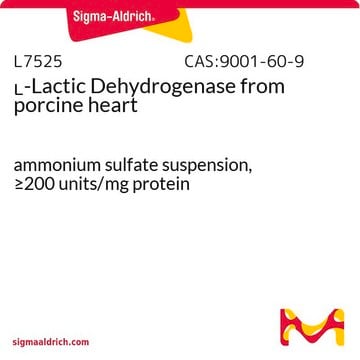L2500
L-Lactic Dehydrogenase from rabbit muscle
Type II, ammonium sulfate suspension, 800-1,200 units/mg protein
Synonym(s):
Lactate, (S)-Lactate: NAD+ oxidoreductase, L-LDH, LAD, LD
About This Item
Recommended Products
type
Type II
form
ammonium sulfate suspension
specific activity
800-1,200 units/mg protein
mol wt
140 kDa
foreign activity
pyruvate kinase, myokinase, malic dehydrogenase, glutamic-pyruvic transaminase, glutamic-oxalacetic transaminase and α-glycerophosphate dehydrogenase ≤0.01%
shipped in
wet ice
storage temp.
2-8°C
Looking for similar products? Visit Product Comparison Guide
General description
Isoelectric point: 8.4-8.6
Optimal pH : 7.5 .
Application
- for protein-binding measurement
- to detect the action of oxaloacetate decarboxylase
- to determine serum L- and D-lactate
Biochem/physiol Actions
Unit Definition
Physical form
Analysis Note
Signal Word
Danger
Hazard Statements
Precautionary Statements
Hazard Classifications
Resp. Sens. 1
Storage Class Code
10 - Combustible liquids
WGK
WGK 1
Personal Protective Equipment
Certificates of Analysis (COA)
Search for Certificates of Analysis (COA) by entering the products Lot/Batch Number. Lot and Batch Numbers can be found on a product’s label following the words ‘Lot’ or ‘Batch’.
Already Own This Product?
Find documentation for the products that you have recently purchased in the Document Library.
Customers Also Viewed
Articles
For use as a marker in SDS-PAGE; Albumin from chicken egg white, For use as a marker in SDS-PAGE; L-Lactic Dehydrogenase from rabbit muscle, Type XI, lyophilized powder, 600-1,200 units/mg protein
Instructions for working with enzymes supplied as ammonium sulfate suspensions
Our team of scientists has experience in all areas of research including Life Science, Material Science, Chemical Synthesis, Chromatography, Analytical and many others.
Contact Technical Service










